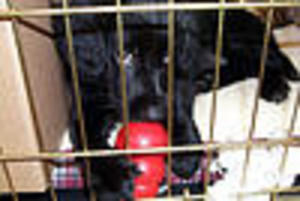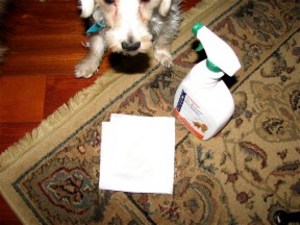New dog owners might feel frustrated when their dog relieves himself inside the house, but you can stop that habit with crate training. Dogs naturally do not want to mess their own area so they will innately learn not to go inside their crate – unless of course, they are sick and just cannot hold it. Since dogs are descendants of wolves, and wolves live in dens, think of a crate as a modern den. Dogs are capable of holding their urine for up to eight hours but dogs should not be left in a crate during the day for more than four hours without being given the opportunity to go out, get some exercise, play, and of course receive love. At night, dogs should be able to hold their bladder for a full eight hours; however, because puppies have a harder time holding their urine, crate training should not begin until the age of five months. You can start crate training sooner but don’t be hard on your puppy if he has an accident here and there; give him a chance for his bladder to fully develop and the opportunity to learn.
Allow Your Dog to Go Out and Get Some Exercise
Provide your dog with water at least an hour before you start any crate training; then allow your dog to go out in the yard so he can relieve himself. If he doesn’t do anything and it’s been a while since he has urinated, then go on the grass with him and act casual. Do not stare at your dog; simply walk around and let him sniff the area before he finds the perfect spot. New dogs are often intimidated in new areas, so give your dog time and let him figure out that this is his yard.
It’s also a good idea to take your dog for a walk before you start to crate train. This will not only allow him to exert energy and get some much needed exercise, but it will also allow him to smell where other dogs have marked their spot. Dogs learn not just from their owners, but from other dogs too. For dogs, urinating is as much about marking their territory as it is about emptying their bladder.
Make the Crate Attractive
Your dog won’t want to go in the crate if it’s not an inviting area, so do your best to make it a cozy den. Place a cushioned crate mat in the kennel along with some toys. You can buy a comfortable crate bed or liner in pet stores like Petco and PetSmart, or from on-line retailers like PetEdge and Drs Foster and Smith. Crate mats come in an array of sizes, colors and shapes – including waterproof liners which are a good idea in the beginning of crate training.
Lure Your Dog with Treats
Dogs loves their treats so place a few of your dog’s kibble or favorite treats in the crate to encourage him to check it out. Praise your dog when he goes in the crate and leave the crate door open. You want him to walk in, sniff around, grab the treat and walk out. After a few times, he will get more comfortable and might even eat the treat in the crate.
Close the Crate
Once your dog is used to going in the crate with the crate door open, try closing the door for a few seconds while he gets the treat. Stay by the crate so your dog can see you and after a few seconds of praise, open the crate and let your dog out.
The idea is to encourage your dog and make him feel like going in the crate is a positive action not a negative one. Increase the amount of time you have the door closed until eventually your dog can be left alone for 10 minutes. If he can stand 10 minutes, then he’s good to go. Some dogs find their crate to be peaceful, relaxing and secure. It’s also a great spot for them to get their much needed doggy naps.
Tips
#1 – If your dog barks when you put him in the crate, try placing a breathable towel over the top to make the crate dark. This will simulate the wolf den which is dark for sleeping.
#2 – If your dog continues to bark, consider using a plug-in or spray that contains a dog appeasing pheromone (D.A.P.). It simulates the hormones that the dog’s biological mother produced when she was nursing her puppies. This is very calming to dogs and is not harmful in any way. These products can be purchased on-line or in any pet retail store. Spray the D.A.P. five minutes before putting your dog in the crate.
#3 – Consider getting an airline approved crate that is large enough for your dog to walk around in. That way your dog won’t be as anxious when he flies because he’ll already be used to his crate.
#4 – Make sure you provide your dog with water but not so much that he’ll have to urinate. Ice cubes in the crate holders (that adhere to the crate door) are a great alternative.
#5 – Place one of your personal items in the dog’s crate so he’ll feel like you are with him. Opt for something that you wear often and has your smell on it (e.g. a shirt that has not been washed yet, a slipper).
Remember to Give Your Dog a Break
Do not leave your dog in the crate during the day for more than four hours without being let out for a potty break. If you cannot get home in time to let your dog out, consider hiring a pet sitter or asking a neighbor or friend to help out. Accidents happen, so instead of yelling at your dog for urinating on the floor when he is in the learning stage, praise him each and every time he goes outside. Use the word “Out” or “Potty” when you see your dog getting ready to urinate inside the house, then quickly take him outside. Remember to use a high tone and say something positive like “What a good boy!” or “Good out!” Repetition is key so don’t cease praising your dog when he finally does learn that he is supposed to go to the bathroom outside.
Crate training is a great tool for house training but it can also be used when you are at work, go on errands, or have guests over during a dinner party. The key to crate training is to make your dog’s crate inviting and a positive experience each time he goes in. If you are still having difficulty after a month of crate training, consider hiring a professional dog trainer or discuss the situation with your dog’s veterinarian.



